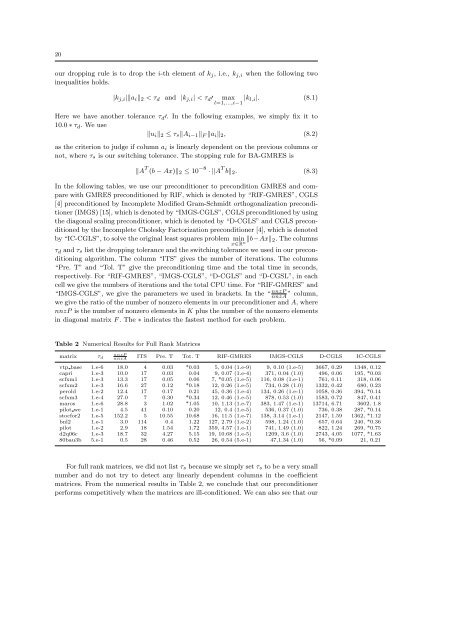Greville's Method for Preconditioning Least Squares ... - Projects
Greville's Method for Preconditioning Least Squares ... - Projects
Greville's Method for Preconditioning Least Squares ... - Projects
Create successful ePaper yourself
Turn your PDF publications into a flip-book with our unique Google optimized e-Paper software.
20<br />
our dropping rule is to drop the i-th element of k j , i.e., k j,i when the following two<br />
inequalities holds.<br />
|k j,i |‖a i ‖ 2 < τ d and |k j,i | < τ d ′ max<br />
l=1,...,i−1 |k l,i|. (8.1)<br />
Here we have another tolerance τ d ′. In the following examples, we simply fix it to<br />
10.0 ∗ τ d . We use<br />
‖u i ‖ 2 ≤ τ s‖A i−1 ‖ F ‖a i ‖ 2 , (8.2)<br />
as the criterion to judge if column a i is linearly dependent on the previous columns or<br />
not, where τ s is our switching tolerance. The stopping rule <strong>for</strong> BA-GMRES is<br />
‖A T (b − Ax)‖ 2 ≤ 10 −8 · ‖A T b‖ 2 . (8.3)<br />
In the following tables, we use our preconditioner to precondition GMRES and compare<br />
with GMRES preconditioned by RIF, which is denoted by “RIF-GMRES”, CGLS<br />
[4] preconditioned by Incomplete Modified Gram-Schmidt orthogonalization preconditioner<br />
(IMGS) [15], which is denoted by “IMGS-CGLS”, CGLS preconditioned by using<br />
the diagonal scaling preconditioner, which is denoted by “D-CGLS” and CGLS preconditioned<br />
by the Incomplete Cholesky Factorization preconditioner [4], which is denoted<br />
by “IC-CGLS”, to solve the original least squares problem min<br />
x∈R n‖b−Ax‖ 2. The columns<br />
τ d and τ s list the dropping tolerance and the switching tolerance we used in our preconditioning<br />
algorithm. The column “ITS” gives the number of iterations. The columns<br />
“Pre. T” and “Tol. T” give the preconditioning time and the total time in seconds,<br />
respectively. For “RIF-GMRES”, “IMGS-CGLS”, “D-CGLS” and “D-CGSL”, in each<br />
cell we give the numbers of iterations and the total CPU time. For “RIF-GMRES” and<br />
“IMGS-CGLS”, we give the parameters we used in brackets. In the “ nnzP<br />
nnzA ” column,<br />
we give the ratio of the number of nonzero elements in our preconditioner and A, where<br />
nnzP is the number of nonzero elements in K plus the number of the nonzero elements<br />
in diagonal matrix F . The ∗ indicates the fastest method <strong>for</strong> each problem.<br />
Table 2 Numerical Results <strong>for</strong> Full Rank Matrices<br />
matrix τ d<br />
nnzP<br />
nnzA ITS Pre. T Tot. T RIF-GMRES IMGS-CGLS D-CGLS IC-CGLS<br />
vtp base 1.e-6 18.0 4 0.03 *0.03 5, 0.04 (1.e-9) 9, 0.10 (1.e-5) 3667, 0.29 1348, 0.12<br />
capri 1.e-3 10.0 17 0.03 0.04 9, 0.07 (1.e-4) 371, 0.04 (1.0) 496, 0.06 195, *0.03<br />
scfxm1 1.e-3 13.3 17 0.05 0.06 7, *0.05 (1.e-5) 116, 0.08 (1.e-1) 761, 0.11 318, 0.06<br />
scfxm2 1.e-3 16.6 27 0.12 *0.18 12, 0.26 (1.e-5) 734, 0.28 (1.0) 1332, 0.42 680, 0.23<br />
perold 1.e-2 12.4 17 0.17 0.21 45, 0.36 (1.e-4) 134, 0.26 (1.e-1) 1058, 0.36 394, *0.14<br />
scfxm3 1.e-4 27.0 7 0.30 *0.34 12, 0.46 (1.e-5) 878, 0.53 (1.0) 1583, 0.72 847, 0.41<br />
maros 1.e-6 28.8 3 1.02 *1.05 10, 1.13 (1.e-7) 383, 1.47 (1.e-1) 13714, 6.71 3602, 1.8<br />
pilot we 1.e-1 4.5 41 0.10 0.20 12, 0.4 (1.e-5) 536, 0.37 (1.0) 736, 0.38 287, *0.14<br />
stoc<strong>for</strong>2 1.e-5 152.2 5 10.55 10.68 16, 11.5 (1.e-7) 138, 3.14 (1.e-1) 2147, 1.59 1362, *1.12<br />
bnl2 1.e-1 3.0 114 0.4 1.22 127, 2.79 (1.e-2) 598, 1.24 (1.0) 657, 0.64 240, *0.36<br />
pilot 1.e-2 2.9 18 1.54 1.72 359, 4.57 (1.e-1) 741, 1.49 (1.0) 822, 1.24 269, *0.75<br />
d2q06c 1.e-3 18.7 32 4.27 5.15 19, 10.68 (1.e-5) 1209, 3.6 (1.0) 2743, 4.05 1077, *1.63<br />
80bau3b 5.e-1 0.5 28 0.46 0.52 26, 0.54 (5.e-1) 47,1.34 (1.0) 56, *0.09 21, 0.21<br />
For full rank matrices, we did not list τ s because we simply set τ s to be a very small<br />
number and do not try to detect any linearly dependent columns in the coefficient<br />
matrices. From the numerical results in Table 2, we conclude that our preconditioner<br />
per<strong>for</strong>ms competitively when the matrices are ill-conditioned. We can also see that our

















